Analyze the potential merger of this hospital with Lafayette General. You may want to consider culture, strategies, specialities and services that both hospitals offer. After completing this assessment what financial strategies, approaches, statistics could be used to develop a value for Lafayette General. Consider culture, strategies, specialities and services that both hospitals offer. After completing this assessment what financial strategies, approaches, statistics could be used
develop a value for Lafayette General.
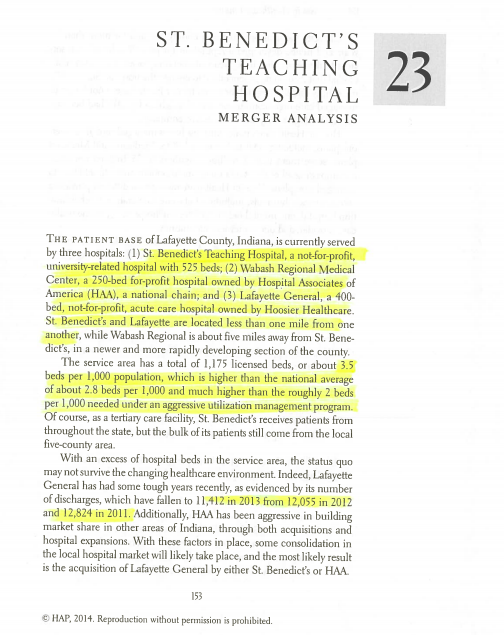


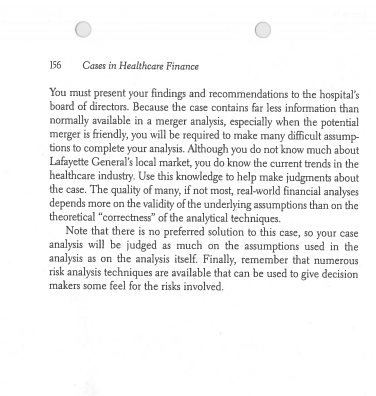
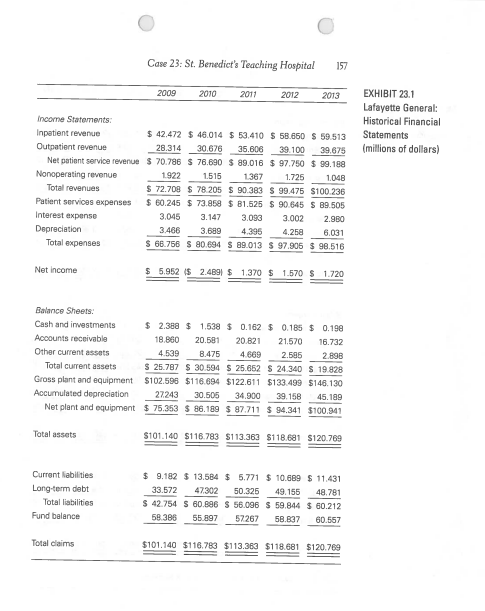
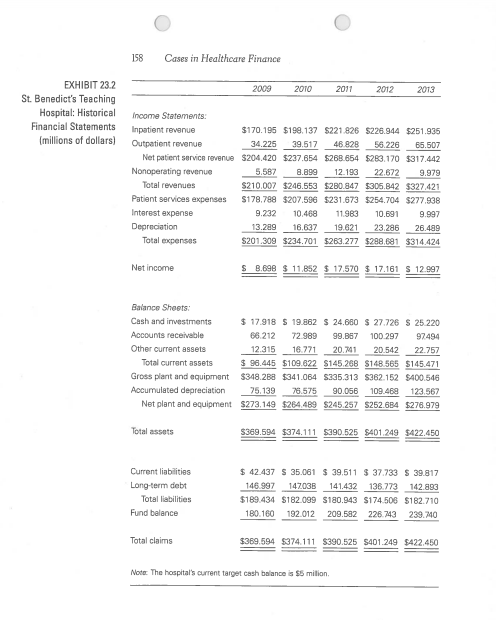

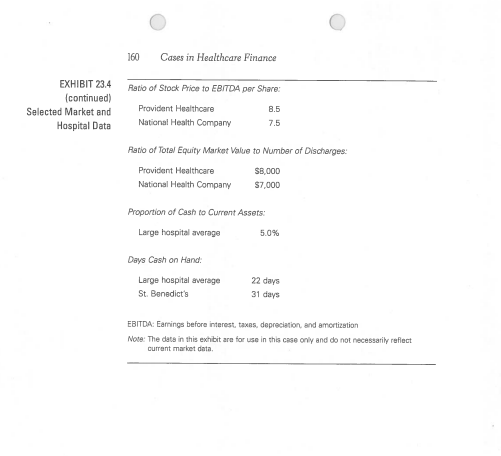
ST. BENEDICT'S TEACHING HOSPITAL MERGER ANALYSIS 23 THE PATIENT BASE of Lafayette County, Indiana, is currently served by three hospitals: (1) St. Benedict's Teaching Hospital, a not-for-profit, university-related hospital with 525 beds; (2) Wabash Regional Medical Center, a 250-bed for-profit hospital owned by Hospital Associates of America (HAA), a national chain; and (3) Lafayette General, a 400- bed, not-for-profit, acute care hospital owned by Hoosier Healthcare St. Benedict's and Lafayette are located less than one mile from one another, while Wabash Regional is about five miles away from St. Bene- dict's, in a newer and more rapidly developing section of the county The service area has a total of 1,175 licensed beds, or about 3.5 beds per 1,000 population, which is higher than the national average of about 2.8 beds per 1,000 and much higher than the roughly 2 beds per 1,000 needed under an aggressive utilization management program Of course, as a tertiary care facility, St. Benedict's receives patients from throughout the state, but the bulk of its patients still come from the local five-county area. With an excess of hospital beds in the service area, the status quo may not survive the changing healthcare environment. Indeed, Lafayette General has had some tough years recently, as evidenced by its number of discharges, which have fallen to 11,412 in 2013 from 12,055 in 2012 and 12,824 in 2011. Additionally, HAA has been aggressive in building market share in other areas of Indiana, through both acquisitions and hospital expansions. With these factors in place, some consolidation in the local hospital market will likely take place, and the most likely result is the acquisition of Lafayette General by either St. Benedict's or HAA 153 HAP, 2014. Reproduction without permission is prohibited. 154 Cases in Healthcare Finance Lafayette General operated as a county hospital for more than 50 years and hence developed a reputation for providing healthcare ser- vices to the poor. After many years of operating losses, the county con- cluded that it could no longer afford to operate the hospital. So, in 1987, the county sold the hospital for $1 to Hoosier Healthcare, a not-for-profit managed care organization and provider, which by 2013 had become the state's largest integrated healthcare company. Hoosier Healthcare's major business line is managed care. Its numer- ous plans, including HMOS; PPOs; and POS Medicare, and Medicaid plans, serve more than 1 million members in 25 Indiana counties, encompassing all of the state's major metropolitan areas. In addition to managed care plans, Hoosier Healthcare owns seven different providers: two acute care hospitals, including Lafayette General; one rehabilita- tion hospital; one mental health facility; one hospice; one home health care provider, and one retirement community. Lafayette General is the flagship of Hoosier Healthcare's provider network, and the company has kept the hospital in excellent condition in spite of falling inpatient utilization. In fact, in recent years, Lafayette General built the state-of-the-art Heart Care Center and its modern Maternity Care Center. Furthermore, Lafayette General operates a full- service emergency department and a medical helicopter service. In response to the current situation, St. Benedict's has formed a spe- cial committee to consider the feasibility of making an offer to Hoosier Healthcare to acquire Lafayette General. The committee's primary goals are as follows: 1. To place a dollar value on Lafayette General's equity (fund) capital, assuming that the hospital will be acquired and operated by St. Benedict's 2. To develop a financing plan for the acquisition In addition, the committee has been asked to consider two other issues related to the potential acquisition: 1. What is the best organizational structure for a combined enterprise? Currently, both Lafayette General and St. Benedict's have separate boards of directors and management staffs. Of course, the senior members of the board of Lafayette General currently are Hoosier Healthcare officers. 155 Case 23: St. Benedict's Teaching Hospital 2. Should the medical staffs of the two hospitals be integrated, and, if so, in what way? The medical staff of Lafayette General consists of local physicians, including many family practice physicians, while the medical staff at St. Benedict's is almost entirely made up of specialists, and all are members of the local university's College of Medicine with responsibilities that go well beyond clinical practice. A new committee will be formed to finalize recommendations on the above issues should St. Benedict's management agree to move forward with the acquisition offer, but some preliminary judgments are sought at this time. As a starting point in the valuation analysis, the com- mittee has obtained historical income statement and balance sheet data on both hospitals. Exhibit 23.1 contains the data for Lafayette General, while Exhibit 23.2 provides the data for St. Benedict's. Both sets of state- ments are abbreviated but still contain the data considered to be most relevant to the analysis. In addition, some relevant comparative data are presented in Exhibit 23.3. Finally, relevant market data are shown in Exhibit 23.4. (Assume that the data in Exhibits 23.3 and 23.4 reflect late-2013 conditions.) One of the toughest tasks that the committee faces is the develop ment of Lafayette General's pro forma (forecasted) cash flow statements, which form the basis of the discounted cash flow valuation. Several basic questions must be answered before any numbers can be generated. First, what synergies, if any, can be realized from the merger, and how long will it take for such synergies to develop? For example, can duplications be eliminated? Both hospitals have mercy flight" helicopters, and both offer full emergency department services, even though the two hospitals are only one mile apart. And what is the impact of such operational changes on revenues and costs and hence on the net cash flows that Lafayette General's assets can produce? Second, once the consolidation takes place and all synergies have been realized, what is the long-term growth prospect for Lafayette General's cash flows? Third, what impact would the acquisition have on St. Benedict's own cash flows? Any change in St. Benedict's revenues or costs that results from the acquisi- tion must be included in the analysis. The answers to these questions, and others, form the basis for the pro forma cash flow statements. Assume that you are the chair of the special committee formed at St. Benedict's Teaching Hospital to evaluate the potential acquisition 156 Cases in Healthcare Finance You must present your findings and recommendations to the hospital's board of directors. Because the case contains far less information than normally available in a merger analysis, especially when the potential merger is friendly, you will be required to make many difficult assump- tions to complete your analysis. Although you do not know much about Lafayette General's local market, you do know the current trends in the healthcare industry. Use this knowledge to help make judgments about the case. The quality of many, if not most , real-world financial analyses depends more on the validity of the underlying assumptions than on the theoretical "correctness of the analytical techniques. Note that there is no preferred solution to this case, so your case analysis will be judged as much on the assumptions used in the analysis as on the analysis itself. Finally, remember that numerous risk analysis techniques are available that can be used to give decision makers some feel for the risks involved. Case 23: St. Benedict's Teaching Hospital 157 2009 2010 2011 2012 2013 EXHIBIT 23.1 Lafayette General: Historical Financial Statements (millions of dollars) Income Statements: Inpatient revenue $ 42.472 $ 46.014 $ 53.410 $ 58.660 S 59.513 Outpatient revenue 28.314 30.676 35.606 39.100 39.675 Net patient service revenue $ 70.786 $ 76.690 89.016 $ 97.750 $ 99.188 Nonoperating revenue 1.922 1.515 1367 1.725 1.048 Total revenues $72.708 $ 78 205 $ 90.383 $ 99.475 $100.236 Patient services expenses $ 60.245 $ 73.858 $ 81,525 $ 90.645 S 89.505 Interest expense 3.045 3.147 3.093 3.002 2.980 Depreciation 3.466 3.689 4.395 258 6.031 Total expenses $ 66.756 S 80.694 S 89.013 S 97.906 $ 98.516 Net Income $5.952 (S 2.4891 $ 1.370 $ 1.570 S 1.720 Balance Sheets: Cash and investments $ 2.388 $ 1.538 $ 0.162 $ 0.185 $ 0.190 Accounts receivable 18.800 20.581 20.821 21.570 16.732 Other current assets 4.539 8.475 4.689 2.585 2.896 Total current assets $ 25.787 S 30.594 $ 25.652 $ 24.340 $ 19.828 Gross plant and equipment $102.598 $116.694 $122.611 $133.499 $146.130 Accumulated depreciation 27243 30.505 34.900 39. 168 45.189 Net plant and equipment $ 75.353 $ 86.189 $ 87.711 $ 94.341 $100.941 Total assets $101.140 $116.783 $113.363 $118.681 $120.769 Current liabilities Long-term debt Total liabilities Fund balance $ 9.182 $ 13.584 $ 5.771 $ 10.689 $ 11.431 33.572 47302 50.325 49.155 48.781 $ 42.754 S 60.896 $ 56.096 $ 59.844 $ 60.212 58.386 55,897 57267 58.837 60 557 Total claims $101.140 $116.783 $113,363 $118.681 $120.769 158 Cases in Healthcare Finance 2009 2010 2011 2012 2013 EXHIBIT 23.2 St. Benedict's Teaching Hospital: Historical Financial Statements (millions of dollars) Income Statements: Inpatient revenue $170.195 $198.137 $221.826 $226.944 $251.935 Outpatient revenue 34.225 39.517 46.828 56.226 65.507 Net patient service revenue $204.420 $237.654 $268.654 $2B3.170 $317.442 Nonoperating revenue 5.587 8.899 12.193 22.672 9.979 Total revenues S210.007 $246.553 $280.947 $305.842 $327.421 Patient services expenses $178.788 $207.596 $231.673 $254.704 $277.938 Interest expense 9.232 10.468 11.963 10.691 9.997 Depreciation 13.289 16.637 19.021 23.286 26.489 Total expenses $201.309 5234.701 5263.277 $288.681 $314.424 Net income S 8.698 $ 11.852 $ 17.570 $ 17.161 S 12.997 Balance Sheets Cash and investments $17.918 S 19.862 $ 24.660 $ 27.726 S 25220 Accounts receivable 66.212 72.989 99.657 100 297 97494 Other current assets 12.315 16.771 20.741 20.542 22.757 Total current assets $ 96.445 $109.622 S145.268 148.565 $145.471 Gross plant and equipment $348.28 $341.064 $335.313 $362.152 $400.546 Accumulated depreciation 75.139 76.575 90.056 109.468 123.567 Net plant and equipment $273.149 1264,489 $245.257 5252.684 $278.979 Total assets $369.594 $374,111 $390.525 $401.249 $422.450 Current liabilities Long-term debt Total liabilities Fund balance $ 42.437 S 35.061 $ 39,511 $ 37.733 S 39.817 146.997 147038 141.432 136.773 142.893 $189.434 $182.099 $180.943 $174.506 $182.710 180.160 192.012 209.582 226.743 239.20 Total claims $369.594 5374 111 $390.525 5401.249 $422.450 Note: The hospital's current target cash balance is $5 milion Case 23: St. Benedict's Teaching Hospital 159 Lafayette St. Benedict's EXHIBIT 23.3 Selected Comparative Data Average age of plant Licensed beds Occupancy rate Average length of stay Number of discharges Medicare percent Medicaid percent Medicare case mix index Gross price per discharge Net price per discharge Cost per discharge 6.8 years 400 52.7% 5.5 days 11,412 57.2% 10.3% 1.51 $11,689 $5,850 $5,703 8.5 years 525 642% 6.6 days 19,748 29.7% 13.0% 2.13 $20,204 $12,757 $12,144 U.S. Treasury Yield Curve: EXHIBIT 23.4 Selected Market and Hospital Data Maturity Interest Rate 6 months 1 year 5 years 10 years 20 years 30 years 3.0% 3.5 3.9 4.5 5.0 5.1 Marker Risk Premium: 70% Historical risk premium Average current risk premium as forecasted by three investment banking firms 6.0% Market Betas, Capitalization, and Tax Rates of Two Publicly Traded Hospital Companies: Company Bete Debt/Asset Ratio Tax Rate Tax Rere Provident Healthcare National Health Company 1.1 12 50% 65% 40% 43% 160 Cases in Healthcare Finance Ratio of Stock Price to EBITDA por Shares EXHIBIT 23.4 (continued) Selected Market and Hospital Data Provident Healthcare National Health Company 8.5 7.5 Ratio of Total Equity Market value to Number of Discharges Provident Healthcare National Health Company $8,000 $7,000 Proportion of Cash to Current Assets: Large hospital average 5.0% Days Cash on Hand Large hospital average St. Benedict's 22 days 31 days EBITDA: Earnings before interest, taxes, depreciation, and amortization Note: The data in this exhibit are for use in this case only and do not necessarily reflect current market data ST. BENEDICT'S TEACHING HOSPITAL MERGER ANALYSIS 23 THE PATIENT BASE of Lafayette County, Indiana, is currently served by three hospitals: (1) St. Benedict's Teaching Hospital, a not-for-profit, university-related hospital with 525 beds; (2) Wabash Regional Medical Center, a 250-bed for-profit hospital owned by Hospital Associates of America (HAA), a national chain; and (3) Lafayette General, a 400- bed, not-for-profit, acute care hospital owned by Hoosier Healthcare St. Benedict's and Lafayette are located less than one mile from one another, while Wabash Regional is about five miles away from St. Bene- dict's, in a newer and more rapidly developing section of the county The service area has a total of 1,175 licensed beds, or about 3.5 beds per 1,000 population, which is higher than the national average of about 2.8 beds per 1,000 and much higher than the roughly 2 beds per 1,000 needed under an aggressive utilization management program Of course, as a tertiary care facility, St. Benedict's receives patients from throughout the state, but the bulk of its patients still come from the local five-county area. With an excess of hospital beds in the service area, the status quo may not survive the changing healthcare environment. Indeed, Lafayette General has had some tough years recently, as evidenced by its number of discharges, which have fallen to 11,412 in 2013 from 12,055 in 2012 and 12,824 in 2011. Additionally, HAA has been aggressive in building market share in other areas of Indiana, through both acquisitions and hospital expansions. With these factors in place, some consolidation in the local hospital market will likely take place, and the most likely result is the acquisition of Lafayette General by either St. Benedict's or HAA 153 HAP, 2014. Reproduction without permission is prohibited. 154 Cases in Healthcare Finance Lafayette General operated as a county hospital for more than 50 years and hence developed a reputation for providing healthcare ser- vices to the poor. After many years of operating losses, the county con- cluded that it could no longer afford to operate the hospital. So, in 1987, the county sold the hospital for $1 to Hoosier Healthcare, a not-for-profit managed care organization and provider, which by 2013 had become the state's largest integrated healthcare company. Hoosier Healthcare's major business line is managed care. Its numer- ous plans, including HMOS; PPOs; and POS Medicare, and Medicaid plans, serve more than 1 million members in 25 Indiana counties, encompassing all of the state's major metropolitan areas. In addition to managed care plans, Hoosier Healthcare owns seven different providers: two acute care hospitals, including Lafayette General; one rehabilita- tion hospital; one mental health facility; one hospice; one home health care provider, and one retirement community. Lafayette General is the flagship of Hoosier Healthcare's provider network, and the company has kept the hospital in excellent condition in spite of falling inpatient utilization. In fact, in recent years, Lafayette General built the state-of-the-art Heart Care Center and its modern Maternity Care Center. Furthermore, Lafayette General operates a full- service emergency department and a medical helicopter service. In response to the current situation, St. Benedict's has formed a spe- cial committee to consider the feasibility of making an offer to Hoosier Healthcare to acquire Lafayette General. The committee's primary goals are as follows: 1. To place a dollar value on Lafayette General's equity (fund) capital, assuming that the hospital will be acquired and operated by St. Benedict's 2. To develop a financing plan for the acquisition In addition, the committee has been asked to consider two other issues related to the potential acquisition: 1. What is the best organizational structure for a combined enterprise? Currently, both Lafayette General and St. Benedict's have separate boards of directors and management staffs. Of course, the senior members of the board of Lafayette General currently are Hoosier Healthcare officers. 155 Case 23: St. Benedict's Teaching Hospital 2. Should the medical staffs of the two hospitals be integrated, and, if so, in what way? The medical staff of Lafayette General consists of local physicians, including many family practice physicians, while the medical staff at St. Benedict's is almost entirely made up of specialists, and all are members of the local university's College of Medicine with responsibilities that go well beyond clinical practice. A new committee will be formed to finalize recommendations on the above issues should St. Benedict's management agree to move forward with the acquisition offer, but some preliminary judgments are sought at this time. As a starting point in the valuation analysis, the com- mittee has obtained historical income statement and balance sheet data on both hospitals. Exhibit 23.1 contains the data for Lafayette General, while Exhibit 23.2 provides the data for St. Benedict's. Both sets of state- ments are abbreviated but still contain the data considered to be most relevant to the analysis. In addition, some relevant comparative data are presented in Exhibit 23.3. Finally, relevant market data are shown in Exhibit 23.4. (Assume that the data in Exhibits 23.3 and 23.4 reflect late-2013 conditions.) One of the toughest tasks that the committee faces is the develop ment of Lafayette General's pro forma (forecasted) cash flow statements, which form the basis of the discounted cash flow valuation. Several basic questions must be answered before any numbers can be generated. First, what synergies, if any, can be realized from the merger, and how long will it take for such synergies to develop? For example, can duplications be eliminated? Both hospitals have mercy flight" helicopters, and both offer full emergency department services, even though the two hospitals are only one mile apart. And what is the impact of such operational changes on revenues and costs and hence on the net cash flows that Lafayette General's assets can produce? Second, once the consolidation takes place and all synergies have been realized, what is the long-term growth prospect for Lafayette General's cash flows? Third, what impact would the acquisition have on St. Benedict's own cash flows? Any change in St. Benedict's revenues or costs that results from the acquisi- tion must be included in the analysis. The answers to these questions, and others, form the basis for the pro forma cash flow statements. Assume that you are the chair of the special committee formed at St. Benedict's Teaching Hospital to evaluate the potential acquisition 156 Cases in Healthcare Finance You must present your findings and recommendations to the hospital's board of directors. Because the case contains far less information than normally available in a merger analysis, especially when the potential merger is friendly, you will be required to make many difficult assump- tions to complete your analysis. Although you do not know much about Lafayette General's local market, you do know the current trends in the healthcare industry. Use this knowledge to help make judgments about the case. The quality of many, if not most , real-world financial analyses depends more on the validity of the underlying assumptions than on the theoretical "correctness of the analytical techniques. Note that there is no preferred solution to this case, so your case analysis will be judged as much on the assumptions used in the analysis as on the analysis itself. Finally, remember that numerous risk analysis techniques are available that can be used to give decision makers some feel for the risks involved. Case 23: St. Benedict's Teaching Hospital 157 2009 2010 2011 2012 2013 EXHIBIT 23.1 Lafayette General: Historical Financial Statements (millions of dollars) Income Statements: Inpatient revenue $ 42.472 $ 46.014 $ 53.410 $ 58.660 S 59.513 Outpatient revenue 28.314 30.676 35.606 39.100 39.675 Net patient service revenue $ 70.786 $ 76.690 89.016 $ 97.750 $ 99.188 Nonoperating revenue 1.922 1.515 1367 1.725 1.048 Total revenues $72.708 $ 78 205 $ 90.383 $ 99.475 $100.236 Patient services expenses $ 60.245 $ 73.858 $ 81,525 $ 90.645 S 89.505 Interest expense 3.045 3.147 3.093 3.002 2.980 Depreciation 3.466 3.689 4.395 258 6.031 Total expenses $ 66.756 S 80.694 S 89.013 S 97.906 $ 98.516 Net Income $5.952 (S 2.4891 $ 1.370 $ 1.570 S 1.720 Balance Sheets: Cash and investments $ 2.388 $ 1.538 $ 0.162 $ 0.185 $ 0.190 Accounts receivable 18.800 20.581 20.821 21.570 16.732 Other current assets 4.539 8.475 4.689 2.585 2.896 Total current assets $ 25.787 S 30.594 $ 25.652 $ 24.340 $ 19.828 Gross plant and equipment $102.598 $116.694 $122.611 $133.499 $146.130 Accumulated depreciation 27243 30.505 34.900 39. 168 45.189 Net plant and equipment $ 75.353 $ 86.189 $ 87.711 $ 94.341 $100.941 Total assets $101.140 $116.783 $113.363 $118.681 $120.769 Current liabilities Long-term debt Total liabilities Fund balance $ 9.182 $ 13.584 $ 5.771 $ 10.689 $ 11.431 33.572 47302 50.325 49.155 48.781 $ 42.754 S 60.896 $ 56.096 $ 59.844 $ 60.212 58.386 55,897 57267 58.837 60 557 Total claims $101.140 $116.783 $113,363 $118.681 $120.769 158 Cases in Healthcare Finance 2009 2010 2011 2012 2013 EXHIBIT 23.2 St. Benedict's Teaching Hospital: Historical Financial Statements (millions of dollars) Income Statements: Inpatient revenue $170.195 $198.137 $221.826 $226.944 $251.935 Outpatient revenue 34.225 39.517 46.828 56.226 65.507 Net patient service revenue $204.420 $237.654 $268.654 $2B3.170 $317.442 Nonoperating revenue 5.587 8.899 12.193 22.672 9.979 Total revenues S210.007 $246.553 $280.947 $305.842 $327.421 Patient services expenses $178.788 $207.596 $231.673 $254.704 $277.938 Interest expense 9.232 10.468 11.963 10.691 9.997 Depreciation 13.289 16.637 19.021 23.286 26.489 Total expenses $201.309 5234.701 5263.277 $288.681 $314.424 Net income S 8.698 $ 11.852 $ 17.570 $ 17.161 S 12.997 Balance Sheets Cash and investments $17.918 S 19.862 $ 24.660 $ 27.726 S 25220 Accounts receivable 66.212 72.989 99.657 100 297 97494 Other current assets 12.315 16.771 20.741 20.542 22.757 Total current assets $ 96.445 $109.622 S145.268 148.565 $145.471 Gross plant and equipment $348.28 $341.064 $335.313 $362.152 $400.546 Accumulated depreciation 75.139 76.575 90.056 109.468 123.567 Net plant and equipment $273.149 1264,489 $245.257 5252.684 $278.979 Total assets $369.594 $374,111 $390.525 $401.249 $422.450 Current liabilities Long-term debt Total liabilities Fund balance $ 42.437 S 35.061 $ 39,511 $ 37.733 S 39.817 146.997 147038 141.432 136.773 142.893 $189.434 $182.099 $180.943 $174.506 $182.710 180.160 192.012 209.582 226.743 239.20 Total claims $369.594 5374 111 $390.525 5401.249 $422.450 Note: The hospital's current target cash balance is $5 milion Case 23: St. Benedict's Teaching Hospital 159 Lafayette St. Benedict's EXHIBIT 23.3 Selected Comparative Data Average age of plant Licensed beds Occupancy rate Average length of stay Number of discharges Medicare percent Medicaid percent Medicare case mix index Gross price per discharge Net price per discharge Cost per discharge 6.8 years 400 52.7% 5.5 days 11,412 57.2% 10.3% 1.51 $11,689 $5,850 $5,703 8.5 years 525 642% 6.6 days 19,748 29.7% 13.0% 2.13 $20,204 $12,757 $12,144 U.S. Treasury Yield Curve: EXHIBIT 23.4 Selected Market and Hospital Data Maturity Interest Rate 6 months 1 year 5 years 10 years 20 years 30 years 3.0% 3.5 3.9 4.5 5.0 5.1 Marker Risk Premium: 70% Historical risk premium Average current risk premium as forecasted by three investment banking firms 6.0% Market Betas, Capitalization, and Tax Rates of Two Publicly Traded Hospital Companies: Company Bete Debt/Asset Ratio Tax Rate Tax Rere Provident Healthcare National Health Company 1.1 12 50% 65% 40% 43% 160 Cases in Healthcare Finance Ratio of Stock Price to EBITDA por Shares EXHIBIT 23.4 (continued) Selected Market and Hospital Data Provident Healthcare National Health Company 8.5 7.5 Ratio of Total Equity Market value to Number of Discharges Provident Healthcare National Health Company $8,000 $7,000 Proportion of Cash to Current Assets: Large hospital average 5.0% Days Cash on Hand Large hospital average St. Benedict's 22 days 31 days EBITDA: Earnings before interest, taxes, depreciation, and amortization Note: The data in this exhibit are for use in this case only and do not necessarily reflect current market data














